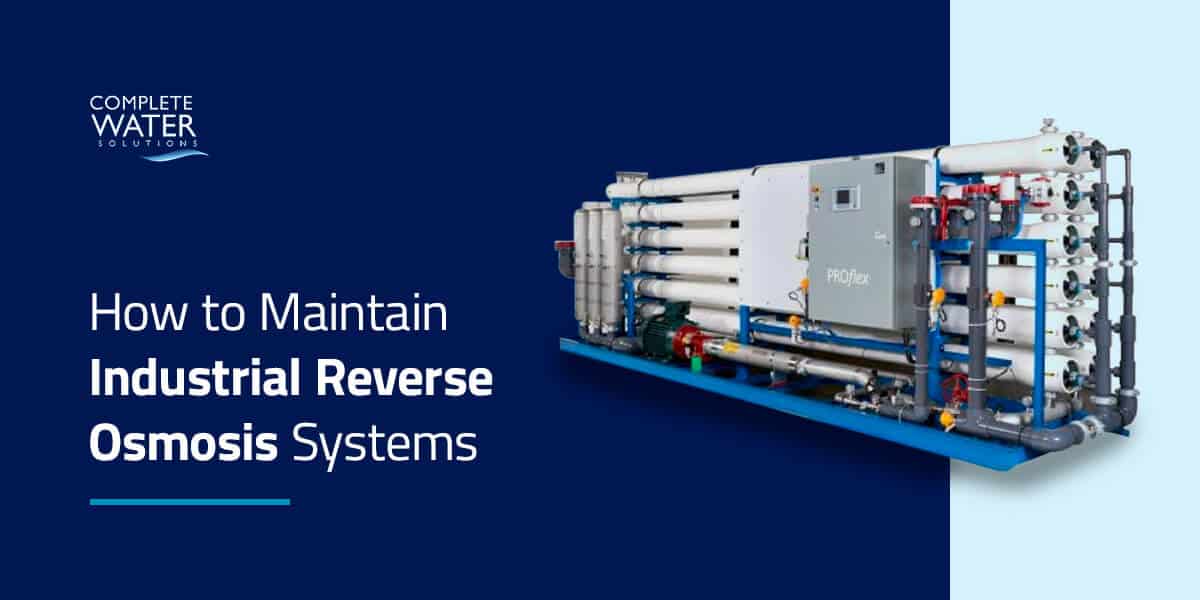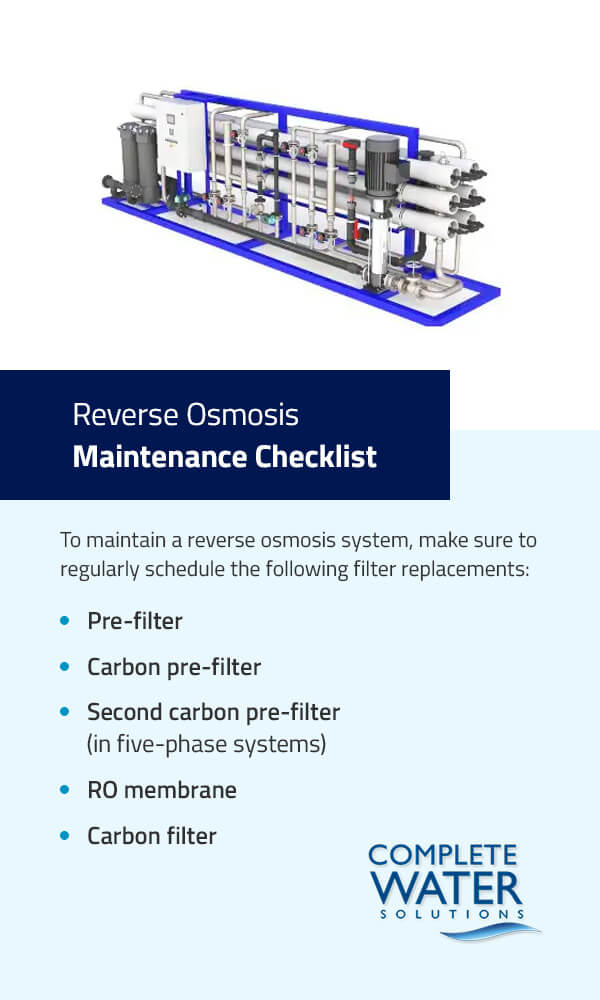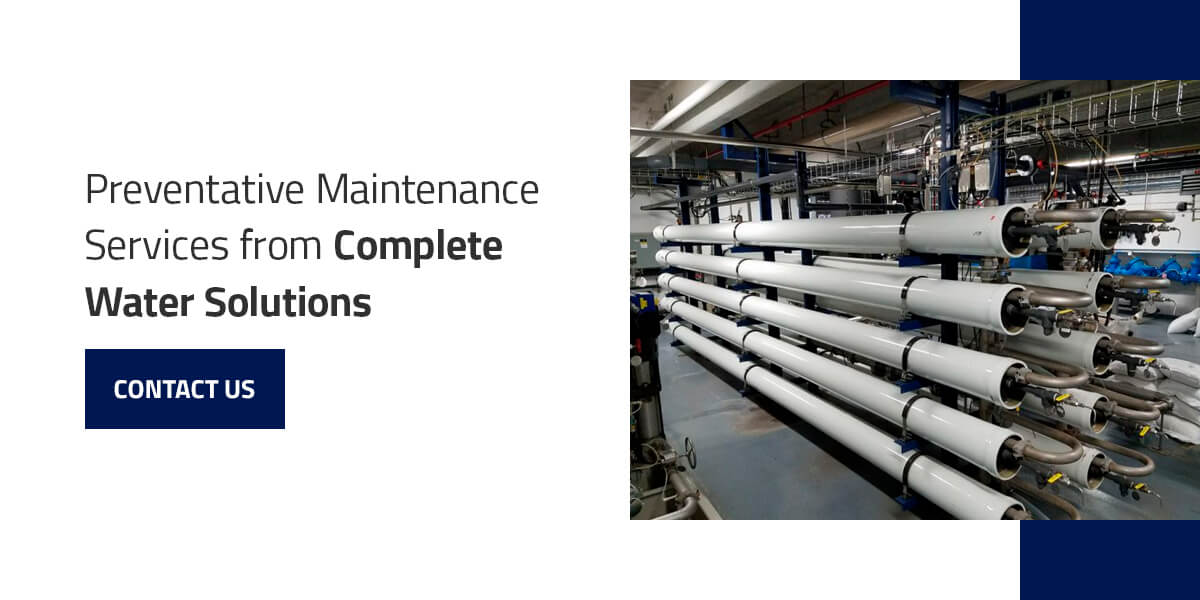How to Maintain Industrial Reverse Osmosis Systems

Reverse osmosis (RO) systems filter water to provide clean water for multiple purposes including manufacturing, ingredients and human consumption. Reverse osmosis is a process that reverses water flow in a natural osmosis process. In this process, water travels through a semi-permeable membrane from a concentrated solution to a more dilute solution. Many RO systems incorporate pre and post-filters along with the semi-permeable membrane. Commercial RO water systems provide highly-purified water for industrial boilers, drinking water systems, food and beverage processing, pharmaceutical production, cosmetics, seawater desalination and other purposes.
RO systems purify water by removing bacteria, viruses, chemical contaminants and protozoa. However, if a system becomes clogged, unclean or damaged, it can compromise the system as well as water quality. To maintain proper industrial RO system operation, cleaning, inspections, preventative maintenance and regular maintenance should be scheduled and performed on a regular basis. RO water system maintenance ensures systems run smoothly with minimal to no issues.
Table of Contents
Why Is RO System Maintenance Important?
RO system maintenance is important because it ensures a system works efficiently and with minimal to no downtime. Preventative maintenance can help to identify issues before they cause damage, and scheduled filter replacements can ensure systems remain unclogged and operate efficiently. Regular cleaning maintains water quality and prevents membrane damage, saving money on expensive replacements. RO system preventative maintenance is an economical way to maintain systems.
How to Maintain an Industrial Reverse Osmosis System
Maintaining an industrial reverse osmosis system involves replacing essential filters to prevent clogging. The individual responsible for maintaining an industrial reverse osmosis system will need to keep track of each filter in the following phases:
Phase 1: Pre-Filter
During phase 1 of reverse osmosis, water passes through a pre-filter to protect fragile reverse osmosis membranes. Pre-filters filtrate sediments such as sand, dirt, silt and other particles. Individuals should change the pre-filter every six to nine months to prevent it from clogging. If this filter becomes clogged, it can cause the pre-filter to collapse or cause particulates to enter the membranes. The person responsible for maintaining an RO system should create a schedule to regularly change the pre-filter.
Phase 2: Carbon Filter
During phase 2 of reverse osmosis, water passes through a carbon filter. The carbon filter removes chlorine and some total organic carbon (TOC). An individual responsible for an RO system should maintain the carbon filter. Testing for chlorine should be done daily. The carbon filter maintenance schedule should be followed per your water treatment guidelines. Chlorine can cause irreversible damage to the RO membranes.
Phase 3: RO Membrane
Phase three is the reverse osmosis phase. During this phase, strong pressure pushes water through the RO membrane. After the water passes through, the membrane holds contaminants on one side while pressure pushes the water back through the membrane to the previous side. Water travels through the membrane at approximately two drops per second, which is 35 pounds for every square inch.
Contaminants travel down the drain after the membrane catches them. The filter and membrane’s lifespans will vary based on facility use and water quality, but the person responsible for maintaining the system should clean the RO membranes when needed and try to replace the RO membrane every two to three years.
Reverse Osmosis Maintenance Checklist
Filters have different lifespans, and they need to be replaced to ensure they run smoothly. To maintain a reverse osmosis system, make sure to regularly schedule the following filter replacements:
- Pre-filter: Replace every month to prevent clogging or based on 10 Psi differential.
- RO membrane: Replace every two to three years.
To install new membranes, you will need to load them in the direction of the water flow. Membrane housing arrows indicate the water flow direction, but if there are no arrows, you can use a flow diagram to identify the system’s flow direction. Insert the membrane so that the brine seal is pointing away from the membrane housing, and push the membrane into the housing.
You can use glycerin, such as Kosher, USP or vegetable grade glycerin, to lubricate membranes and help with installation. After the membrane is in the housing, place the end cap on the end of the housing that the arrow points to.
How to Clean a Reverse Osmosis System
RO system membranes can collect fouling, which is rejected solute buildup that accumulates gradually. Flushing RO membranes can reduce buildup, but RO systems still require regular cleaning to operate properly and prevent membrane damage.
Cleaning RO membranes saves money on replacements because it prevents system damage and extends membrane lifespans. If the system operates in unclean conditions over an extended period, performance recovery can be difficult because unclean conditions can cause irreparable damage to membrane performance, resulting in expensive replacements. Following cleaning schedule guidelines can ensure an optimum cleaning response, and a clean reverse osmosis tank will maintain healthy water quality.
When Should I Clean a Reverse Osmosis System?
You should clean your reverse osmosis system when the normalized flow decreases from the preliminary acceptance test conditions by 10%, or when the overall pressure drop exceeds the preliminary acceptance test conditions by 15%. Increased salt passage can also indicate that a system needs to be cleaned. It’s best to clean systems during scheduled maintenance protocols or right before any medium or long-term shutdowns. You should typically clean your system every three to six months, or as soon as you notice any potential system issues.
Reverse Osmosis Cleaning Procedure
The RO membrane cleaning procedure is typically an easy task, but it can cause system issues if completed incorrectly. Problems can arise from applying the wrong cleaning solutions to improperly using the clean in place (CIP) system. Even if you perform periodic cleaning at the correct time, temperature and flow rate, using inappropriate chemistry can compromise the system.
With various RO membrane cleaning options, you should analyze your system operations and water to determine your system’s best cleaning option. Monitor the system’s performance and main plant parameters to detect any signs of membrane fouling. Increased salt passage, increased pressure loss and water flow loss are all indications to look for.
Before your system needs a chemical cleaning, determine the membrane’s most likely fouling. For example, you may notice increased pressure drops during the first system phase. This could indicate organic, inorganic or bacterial fouling, which typically benefits from a low pH soak and an alkaline cleaning. Elevated pressure drops during the final system phase can indicate mineral deposition.
To clean a reverse osmosis membrane, it’s important to recognize which minerals are most likely deposited. System or antiscalant projections, as well as new mineral analysis on the concentrate and feed, can be helpful. Carbonate scales may require low pH cleaners, and sulfate scales may require alkaline chelant cleaners. The following membrane foulants can compromise an RO system:
- Suspended solids: An increased pressure drop and lower permeate flow can indicate that suspended solids are responsible for an unclean system.
- Hydrogen sulfide: Hydrogen sulfide in the presence of metals will form sulfur and metal sulfides. These will decrease permeate flow and increase pressure drop.
- Metals (iron, aluminum and manganese): Metal fouling can decrease permeate flow and increase pressure drop. When metals oxidize RO membranes, the permeate flow will be higher, and the salt rejection will be lower.
- Microbial and biofilm foulants: Microorganisms, such as bacteria and organic compounds, will cause lower permeate productions and the need for higher pressure.
- Silica: When colloidal silica causes membrane fouling, permeate flow will decrease and pressure drop will increase.
- Hydrocarbons: Hydrocarbons will not enter the water unless human activities or ship spills leak them into it. This type of contaminant prevention is important because even a small concentration of hydrocarbons can have a significant membrane fouling effect.
- Polymers: Polymers create a fouling film when they reach RO membranes, which prevents water flux. This increases pressure drop and decreases permeate flow.
- Calcium sulfate and calcium carbonate (CaCO3): Low salt rejection and low permeate production can indicate the presence of calcium carbonate and calcium sulfate.
Cleaning the RO membrane is the only way to recover system capacity after contamination. Before choosing a cleaning method, check the membrane specifications to ensure you choose the correct RO membrane cleaning chemicals and sequence. Depending on the type of foulant, you will need to implement one of the following cleaning treatments:
- Low pH chemicals: Low pH chemicals will clean inorganic colloidal fouling, sulfate scale and carbonate.
- High pH chemicals: High pH chemicals will clean biofouling and organics.
- Bacteria removal at high pH or with specific biocides: Specific biocides or high pH chemicals can remove bacteria.
- Low pH chemical and high pH chemical combination: When mineral scale and organics are present, it’s best to start with a low pH cleaning chemical to remove the mineral scale and then follow with a high pH cleaning chemical to remove any organics.
To clean an RO membrane, you can follow these steps:
- Open the concentrate valve and use permeate water to flush the system.
- Attach the recirculation pump to the membrane feed inlet.
- Attach the concentrate outlets and permeate to the chemical tank.
- While controlling the pH, recirculate the cleaning chemical for one hour.
- Use permeate water to rinse the membrane and remove any chemical traces.
- Repeat the cycle for each cleaning chemical needed.
The most common RO membrane cleaning method for industrial and commercial systems is on-site cleaning, also referred to as Clean-in-Place (CIP). You can perform this type of cleaning while membranes remain inside pressure vessels. This method is often cheaper and faster than off-site cleaning, which involves removing membranes and shipping them to a separate facility.
While off-site cleaning can be expensive, it is typically a more efficient cleaning method. Off-site cleaning is more thorough and can help ensure you have a system that’s clean and running efficiently.
What Does RO System Preventative Maintenance Include?
RO system preventative maintenance helps RO systems operate efficiently and at peak performance. Preventative maintenance helps to prevent emergencies, prolong a system’s lifespan, save companies money on expensive repairs and reduce system downtime. It helps companies identify issues before they cause system damage, contaminate water or shut down production. Preventative maintenance can include the following services:
- Building engineer check: Technicians will communicate with the building engineer to gather information about the system’s performance.
- Water quality inspection: This inspection involves checking water for iron, hardness, RO quality, chlorine leakage and overall quality.
- Exterior system inspection: The exterior system check includes checking tanks, piping and valves for corrosion, leaks or exterior damage.
- Softener systems valve operation inspection: This inspection involves checking regeneration and service cycle flow patterns for proper operation.
- Brine system inspection: This inspection involves checking the brine tank level, rinse cycle, valve, draw and rate.
- Media filtration valve operation inspection: This inspection involves checking backwashing and service cycle flow patterns for correct operation.
- Controls inspection: This check involves observing controls for correct programming and operation and adjusting the controls when necessary.
- RO inspection: RO inspection involves checking the membrane, pre-filters, pressure, motor and pump.
- Electrodeionization (EDI) system inspection: This inspection involves checking the EDI for electrical consumption, quality and resistivity output. It also includes checking water and wiring connections and adjusting them as needed.
- Probe and monitor calibration: Calibrating probes and monitors involves checking the resistivity, conductivity, chlorine, hardness, pH and ORP.
- Inspection report: An inspection report completed after each inspection includes all relevant data.
- Training: Hands-on training opportunities allow personnel to learn about the RO system so that they can identify when potential issues arise and schedule preventative maintenance.
It’s important to work with experienced technicians to create a preventative reverse osmosis maintenance schedule and maintain industrial and commercial RO systems. Experienced technicians can help make sure systems are clean and resolve issues when needed. This will ensure systems operate smoothly, water quality remains in good condition and expensive repairs are prevented.
Learn More About Our Preventative Maintenance Services
Reverse osmosis maintenance keeps your RO system running properly and prevents you from paying for expensive damage repairs. Regular cleaning and filter replacements ensure you maintain peak water quality and system operation. The experienced technicians at Complete Water Solutions have the training and certifications to identify RO system issues and replace or repair what is needed quickly. We offer 24/7 contactless support, so you can have preventative maintenance assistance whenever you need it.
Servicing reverse osmosis systems is important, and it’s most successful when completed by professionals. We service all major manufactured water treatment systems, and we offer free training to help you remain knowledgeable about your system. We will help you keep your system running efficiently and maintain water quality.
Clean water is important for health and safety. Protect and keep your system running smoothly with preventative maintenance services from Complete Water Solutions. Contact us to schedule a preventative maintenance visit for your RO system.



